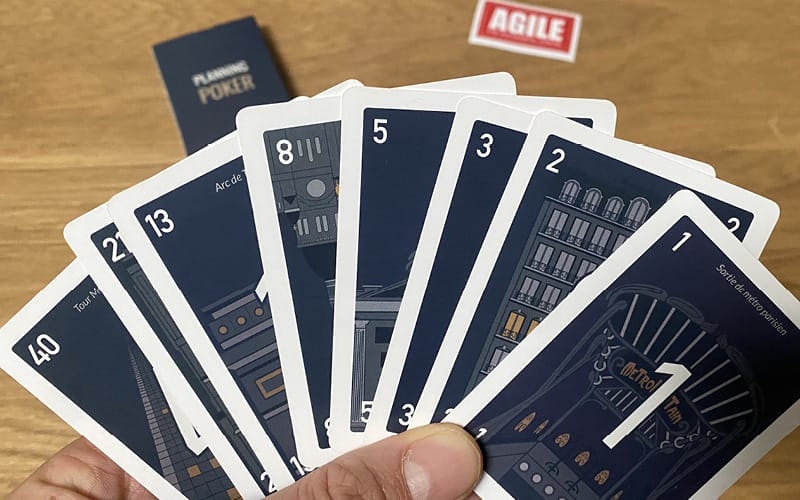PLANNING POKER: A COLLABORATIVE TOOL FOR BETTER TASK ESTIMATIONS

Planning Poker is a task estimation technique primarily used in Agile development teams, especially those following the Scrum framework. This collaborative tool aims to provide accurate estimates of the efforts required to complete project tasks while fostering the participation of every team member.
1. Concept
Planning Poker, also known as Poker Planning, is a relative task estimation method. It relies on a series of discussions and collective evaluation where each team member shares their opinion on the complexity of a task. The goal is to avoid individual biases and encourage consensus by incorporating the viewpoints and expertise of everyone involved.
Inspired by playing cards, Planning Poker uses a specially designed deck, with numbers representing story points (effort points) or similar estimation units. The card values often follow a sequence close to Fibonacci numbers (1, 2, 3, 5, 8, 13, etc.), which helps reflect the variability in estimates as task complexity increases.
2. How It Works
The Planning Poker process typically takes place during a backlog refinement or sprint planning meeting and involves the following steps:
- Task Selection: The Product Owner or Scrum Master selects a user story or task from the product backlog.
- Task Discussion: The team briefly discusses the task to ensure everyone understands the objectives, needs, and potential challenges.
- Individual Estimation: Each team member secretly selects a card representing their estimate of the task’s complexity or the time needed to complete it.
- Card Reveal: All participants reveal their cards simultaneously to avoid mutual influence.
- Discussion of Discrepancies: If the estimates vary significantly, team members discuss the reasons behind their evaluations. Those with the highest and lowest estimates explain their views, allowing the team to reassess the task’s complexity.
- Re-estimation: After the discussion, participants can adjust their estimates and play a new card. This process continues until consensus is reached or an average estimate is chosen.
3. Benefits
Planning Poker offers several advantages:
- Improved Accuracy of Estimates: By confronting different viewpoints, the team obtains a more balanced and accurate estimate than relying on a single person’s opinion.
- Reduced Estimation Bias: By eliminating external influences, this method allows each team member to give their real estimate without being swayed by leaders or dominant opinions.
- Encouraging Communication and Understanding: The discussions around estimate discrepancies help team members better understand tasks and anticipate potential problems.
- Strengthening Team Cohesion: Planning Poker is a collaborative activity that encourages participation from all members, thus fostering a sense of belonging and team spirit.
4. Using Planning Poker
To get the most out of Planning Poker, certain factors should be considered:
- Story Points or Estimates in Days: Planning Poker is often based on story points, which measure relative complexity. This differs from time-based estimates like hours or days, which are more absolute. Story points allow teams to focus on task difficulty rather than exact duration.
- An Iterative Approach: Since Planning Poker relies on a series of discussions and re-evaluations, some time should be allocated for the team to reach consensus.
- Adaptation to the Team: The team’s size, experience level, and project context can influence how Planning Poker is conducted. Therefore, certain aspects can be adapted to better suit the team’s specific needs.
5. Implementing Planning Poker in a Team
To successfully integrate Planning Poker, follow these steps:
- Introduce the Method: Before starting, ensure team members are familiar with the concept of Planning Poker, especially if they haven’t used collaborative estimation methods before.
- Prepare the Right Environment: A calm meeting, free from interruptions, is essential for maximum concentration. For distributed teams, digital tools like Jira, Miro, or PlanningPoker.com allow for remote Planning Poker sessions.
- Encourage Open Discussion: The Scrum Master should encourage all team members to share their opinions, especially those who might hesitate to speak up, ensuring a complete and diverse estimation process.
- Limit the Number of Tasks to Estimate: To avoid cognitive fatigue, it’s better to limit the number of tasks being estimated in a single Planning Poker session.
6. Common Mistakes to Avoid
Planning Poker can be ineffective if certain mistakes are made. Here are the most common ones:
- Imposing a Dominant Opinion: If a team member, especially an experienced one, overly influences others’ estimates, it skews the results and reduces estimation quality.
- Seeking Precise Time Estimates: Planning Poker is a relative estimation method. Attempting to match estimates to precise hours or days can lead to confusion.
- Over-debating Each Task: While discussions are important, they shouldn’t last too long. The goal is to quickly converge on a consensus.
- Skipping Retrospectives: After a few Planning Poker sessions, it can be helpful to conduct a retrospective to see if estimates align with actual sprint outcomes and adjust the method if needed.
7. Conclusion: A Major Asset for Agile Teams
Planning Poker is an effective task estimation method for Agile projects, helping to align the team around a common goal and generate realistic estimates. While it requires some time and preparation to implement, the benefits in terms of accuracy, collaboration, and motivation make it a valuable tool.
By following best practices and avoiding common pitfalls, Planning Poker can become a cornerstone of success for development teams, facilitating sprint planning and project success.
